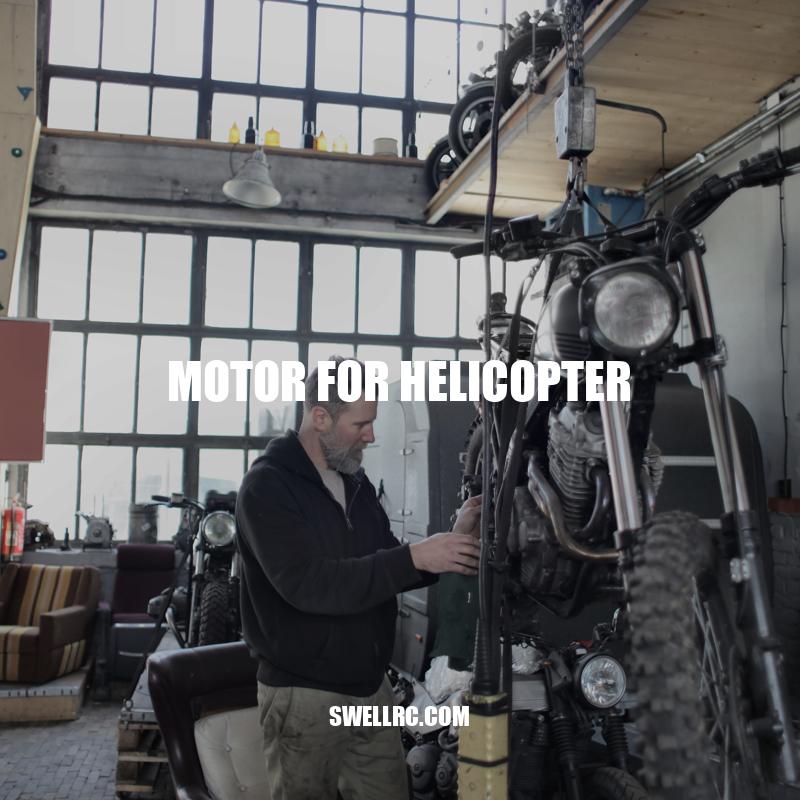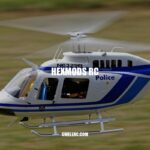Helicopter Motors: Types, Selection, Maintenance, and Future Advancements
Helicopter motors are the beating heart of these aircraft. They provide the necessary power to lift the helicopter vertically, transition to horizontal flight, and perform various complex maneuvers. Unlike fixed-wing aircraft, the motor is the sole source of propulsion in a helicopter. As such, a powerful and reliable motor is a critical component for safe and efficient helicopter operation. The modern-day helicopter motor has undergone various technological advancements and innovations to improve its performance, efficiency, and capabilities. Helicopter motors are designed for various applications, ranging from small, lightweight engines for civilian use to large, heavy-duty motors for military and commercial purposes. The selection of the appropriate helicopter motor takes into account factors such as the intended use of the helicopter, the altitude, weather conditions, and the physical size and weight of the motor. Overall, helicopter motors continue to evolve, and with the latest technological advancements, future helicopter engines are likely to be lighter, more efficient, and capable of producing even more power.
Types of Helicopter Motors
Helicopter motors can be broadly categorized into two types: turbine engines and reciprocating engines. Both types of motors have their unique advantages and disadvantages that impact the performance, cost, and maintenance of the motor. Here is a breakdown of the two main types of helicopter motors:
- Turbine engines: These are the most commonly used type of helicopter motor and are characterized by their high power output, lightweight structure, and long lifespan. They provide greater altitude capabilities and excellent high-altitude performance. Turbine engines are ideal for large helicopters used for transport, commercial, and military purposes, and require minimal maintenance.
- Gas turbine engines
- Turboshaft engines
- Turbofan engines
- Turboprop engines
- Reciprocating engines: These engines are less powerful than turbine engines but are simpler, less expensive, and more durable. They are used in smaller helicopters designed for private and recreational use and are ideal for performing light aerial tasks.
- Radial engine
- In-line engine
When selecting a helicopter motor, it is crucial to consider the intended use of the helicopter, the engine’s cost, weight, and maintenance cost. Several websites provide detailed information on the different types of helicopter motors, including their features, specifications, and prices. These websites include Aircraft Compare, HeliPower, and Helis.com. It is essential to conduct research and seek expert advice before choosing a helicopter motor that best suits your needs.
What are the 2 types of electric motors?
As we all know, electric motors are widely used in various industries due to their efficiency and effectiveness. But did you know that there are two main types of electric motor? That’s right, the two types are AC motors (alternating current) and DC motors (direct current).
So, what’s the difference between the two? Well, AC motors are designed to operate on alternating current, which means the current changes direction periodically. They are used in a variety of applications such as household appliances, small tools, and industrial machinery. On the other hand, DC motors operate on direct current, which means the current flows in only one direction. These are commonly found in battery-powered devices like electric cars, robotics and drones.
It’s important to note that both types of electric motors are highly adaptable to the industry and requirements of the product, making them the perfect fit for a wide range of applications. Understanding the difference between AC and DC motors can help you choose the right kind of motor for your specific needs.
Factors to Consider When Choosing a Helicopter Motor
Several factors must be taken into account when selecting a helicopter motor. Here are some of the main factors to consider:
- Physical size and weight: The physical size and weight of the motor can significantly affect the helicopter’s overall weight and performance. Therefore, it is essential to consider the weight, size, and shape of the motor when selecting a helicopter motor.
- Fuel consumption and efficiency: Fuel consumption and efficiency relate to the amount of fuel needed to operate the motor and how efficiently the engine converts fuel into power, respectively. These factors play a significant role in the running costs of the helicopter.
- Power output: The power output of the motor must be sufficient to lift the helicopter’s weight, passengers, and cargo. The amount of power required depends on the intended use and the type of helicopter.
- Manufacturer and Warranty: Considering the motor manufacturer’s reputation can help ensure that the motor is reliable and durable. Additionally, it is essential to ensure that the manufacturer provides a warranty, which covers repair or replacement of any faulty parts.
It is also essential to understand the types of rotorcraft for which the different types of helicopter motors are designed. For instance:
| Types of Helicopter Motors | Suitable Rotorcraft Types |
|---|---|
| Turbine Engines | Commercial, Military, Transport |
| Reciprocating Engines | Light-utility, Private, Recreational |
Several websites can help you determine appropriate motor selection criteria. Some of the most popular ones include Vertical Magazine and Aircraft Compare. They provide a wealth of information on the different types of helicopter motors, their features, specifications, and prices.
Which motor to use for a helicopter?
When it comes to choosing the right motor for a helicopter, there are a few factors to consider. Reciprocating engines, also known as piston engines, are typically the go-to choice for smaller helicopters. These types of engines are popular in training helicopters as they are relatively easy to operate and cost-effective.
While reciprocating engines are a reliable choice for smaller helicopters, they may not offer the same power as turbine engines. Turbine engines pack more punch and can be used in a wider variety of helicopter models. In fact, many larger helicopters use turbine engines to help them soar through the skies with ease.
Whether you choose a reciprocating or turbine engine for your helicopter will depend on your specific needs and budget. Ultimately, both options have their own unique benefits and drawbacks. When selecting a motor, it’s essential to consider factors such as power, cost, and complexity to make the best decision for your needs.
Maintenance and Care for a Helicopter Motor
Apart from proper selection, regular maintenance, and care are essential for the longevity of a helicopter motor. Here are some of the essential maintenance measures:
- Regular inspections: Regular inspections help detect any potential problems before they worsen. Inspections should cover the powerplant, fuel systems, electrical systems, and other motor components.
- Fluid and oil changes: Regular oil changes help maintain the motor’s lubricity, prevent overheating, and avoid wear and tear of the engine components. Depending on the usage, fluids such as hydraulic fluid, coolant, and brake fluid should also be replaced.
- Cleaning and debris removal: Dirt, debris, and corrosion can accumulate in the motor, contributing to increased wear and tear. Therefore, regular cleaning and debris removal from the motor’s intake, exhaust, and cooling systems is essential.
- Replacing and servicing worn-out parts: Worn-out motor parts should be replaced or serviced to prevent further damage and ensure optimal performance of the motor.
Several websites offer information on maintenance, repair, and overhaul services for helicopter motors. Some of these websites include MT Spares, which provides helicopter engines and component overhaul services, and Aviation Maintenance Magazine, which publishes updates on technological advancements, regulations, and maintenance tips in helicopter motors.
Interestingly, helicopter motors are subjected to more intense operating conditions compared to aircraft engines since they need to run at maximum power output most of the time to maintain flight. Additionally, helicopters fly at very low altitudes, meaning they are more prone to hitting foreign debris, dust, and dirt, contributing to the wear and tear of the engine components.
What are the 3 types of helicopter maintenance?
Helicopters are complex machines that require regular maintenance to ensure they function safely and efficiently. There are several types of helicopter maintenance, but three specific types are required by the Federal Aviation Administration (FAA) to maintain the highest safety standards.
1. Daily/Pre-flight Maintenance: This type of maintenance is performed before every flight to check the helicopter’s vital systems, including fuel, oil, hydraulics, and electronics. Experienced helicopter mechanics inspect the rotor blades, engine components, and landing gear to ensure that everything is in proper working order. They also check the helicopter’s weight and balance to ensure it’s correctly loaded.
2. Scheduled Maintenance: This type of maintenance is performed at specific intervals and is usually based on flight hours or time in service. During scheduled maintenance, helicopter mechanics perform more in-depth inspections and tests, looking for signs of wear and tear, fatigue, and corrosion. They replace parts, lubricate moving components, and perform other tasks to keep the helicopter in peak condition.
3. Unscheduled Maintenance: This type of maintenance is done when something unexpected happens, causing a helicopter to become inoperable or unsafe to fly. It may be caused by a mechanical failure, a small malfunction or a bird strike. The problem must be corrected as soon as possible to prevent further damage or a potential accident. Unscheduled maintenance usually requires a quick response and efficient diagnosis, followed by efficient and skillful repair by experienced mechanics.
In conclusion, these three types of maintenance work hand in hand to ensure that helicopters are safe and ready to fly whenever you need them. By having a maintenance schedule in place, helicopter owners can prevent costly repairs, keep downtime to a minimum, and ultimately extend the lifespan of their aircraft.
Conclusion
To sum up, helicopter motors are crucial for the performance and capabilities of these aircraft. Proper selection, maintenance, and care are necessary to ensure optimal performance and longevity of the motor. When selecting a helicopter motor, factors like physical size and weight, fuel consumption, and power output must be considered. Routine maintenance checks, fluid and oil changes, cleaning, and debris removal, as well as replacing and servicing worn-out parts, are essential for the motor’s upkeep. With various technological advancements, it is essential to keep updated with the latest information and trends in helicopter motor technology. The future of helicopter motors looks promising as advancements in material science, engineering, and manufacturing lead to the development of greener, quieter, and more efficient motors. Overall, investing in a high-quality motor and conducting regular maintenance is crucial for the safe and efficient operation of a helicopter.



